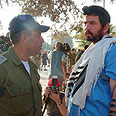
What happened to the militants?
Before the disengagement a series of statements from the far right threatened to halt the disengagament at any cost; what happened?
At the end of the day, those that threatened were stopped. Those that held weapons and fortified themselves gave in. And those that promised blood, smoke, and fire before the disengagement backtracked.
A host of militant figures surrendered unconditionally, mainly due to the determination of settler and religious leaders to stop them.
Those leaders were not prepared to see Israeli blood spilt on the day after Gush Katif disappeared from the map.
The leaders of Gush Katif felt the heavy weight of the responsibility not to see a tear in the nation, and acted on it.
In the most serious confrontations that developed in Gaza, the leadership stopped the ‘hilltop shabab’ (youth activists) which pushed for violent resistance.
Those among the far right, however, think that the surrender to the ‘forces of expulsion’ was an embarrassment.
They see the leaders of Gush Katif as being guided by defeatism, and charge them with allowing the army to stroll into the settlements and take them within eight days.
Armed and fortressed in: Aryeh Yizhaki (Photo: AP)

The extreme right wing activists were prepared to undertake any provocative step to halt the pullout, almost everything was kosher was from their perspective.
But, to their sorrow, the residents and leaders of Gush Katif flexed their muscles and, with a bit of an effort, ensured restraint. The far right was pushed to its natural place – the margins of Israeli politics.
On the morning after the disengagement from Gaza and northern Samaria, the evacuees feel that they have emerged as victors. True, they lost their homes, green houses, and Torah schools, but they prevented a civil war in Israel in the summer of 2005.
“The IDF is a strong army, it was clear to us that we couldn’t over come it,” said rabbi Yigal Kirshenzfat, a chabad member who lived in Gush Katif, who was seriously injured by a Palestinian mortar a few weeks before the disengagement.
“We asked ourselves, what would we gain from spilling Israeli blood. We are after all one nation and we are all brothers. We may have lost the small battle for Gush Katif, but we won the bigger war, the war for Israel’s spirit.”
“Sharon is a dog of war. He lives and is nourished by war. He wanted a civil war,” said Ami Shaked, head of Gaza Coastal Area security, and one of the people placed on the security forces wanted list.
Shaked will lock Gush Katif’s gate next week, and is one of the last residents to leave.
“Unlike Sharon, we decided that there won’t be a civil war. We won’t be part of the destruction of the third temple. We concluded that the state is more important than our private homes,” he said.
Other hard-line figures share the long term view of optimism. Oz Kadmon, a leading militant in Kfar Darom, said: “We lost the battle for Gush Katif, but this is only the start of a series of battles for the State of Israel,” said Kadmon.
Perhaps the best explanation for the fact that blood was not spilt during the clearing of Gush Katif is concealed in the following explanation.
3000 years after the baby’s biological mother told Solomon not to harm her child, (during a dispute over a baby claimed by two mothers, Solomon said he would split the baby with a sword, and awaited for the real mother to protest), her words were used by rabbi David Gabrieli from the famous Yamit yeshiva to explain the relatively peaceful clearance of Gush Katif.
“Like that mother, who saw the life of her child as most important, we are saying, ‘don’t cut.’ We know we are one people and a long road awaits us, one that we will travel down together,” said the rabbi, as many cried while saying their farewell prayers before leaving the Gaza Strip.










